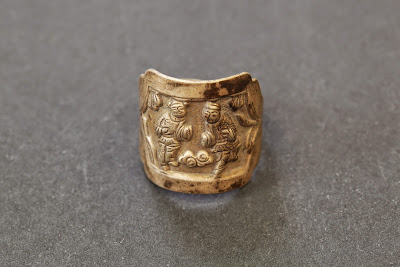From the earliest days of Chinese civilisation, a royal concubine reportedly received a silver ring each time she spent the night with the emperor. Throughout the lovemaking, she wore the ring on her right hand. Upon being discharged, she switched the ring to her left hand. If she became pregnant, she earned a gold ring.
By the Qing dynasty, even common women could afford simple rings and these have survived in plain silver or in a slightly more elaborate enamelled form. The designs were spare fruits, fish, flowers, animals of the zodiac, double happiness symbols and the swastika.
More intricate imagery covered the rings of wealthier citizens. On such pieces, we can find detailed flowers, animals and birds, and the ever popular frog for fertility.
Rings featuring engraved stacks of books might have been owned by either a man or a woman. Since wealthy, privately educated women were writing and publishing poetry as early as the 17th century in China, it's entirely possible that they wore rings bearing literary themes.
Rings engraved with theater scenes often referred to as "opera rings" represented a unique tradition. Traveling Peking opera companies sold such rings as souvenirs of their performances.
Pictures below are the antique Chinese carved silver rings from my collection. The rings features a wonderful figural design and are adjustable.
By the Qing dynasty, even common women could afford simple rings and these have survived in plain silver or in a slightly more elaborate enamelled form. The designs were spare fruits, fish, flowers, animals of the zodiac, double happiness symbols and the swastika.
More intricate imagery covered the rings of wealthier citizens. On such pieces, we can find detailed flowers, animals and birds, and the ever popular frog for fertility.
Rings featuring engraved stacks of books might have been owned by either a man or a woman. Since wealthy, privately educated women were writing and publishing poetry as early as the 17th century in China, it's entirely possible that they wore rings bearing literary themes.
Rings engraved with theater scenes often referred to as "opera rings" represented a unique tradition. Traveling Peking opera companies sold such rings as souvenirs of their performances.
Pictures below are the antique Chinese carved silver rings from my collection. The rings features a wonderful figural design and are adjustable.



















